Since we live a holistic, natural lifestyle, it only made sense for us to give this same life to our new fur-family member! We discovered that it doesn’t take much effort on our part to give this life gift to our dog because we already have everything we need to feed her. We don’t buy treats; we give her things we already have if it’s a whole food item: meat, berries, veggies, etc.
Luckily, we found a holistic veterinarian, and we brought Roux for her first check-up.
I didn’t even know that holistic veterinary practice existed! Dr. Sagrera was amazing. She was extremely informative, and I could tell that she was very passionate about the proper “natural” care of our dog.
Who is Roux? Read Life with Roux #001: Our Milestone Dog.
At Roux’s first visit, it was determined that her nutrition was not well-balanced. We were informed of exactly which foods to feed her and also how to feed her a raw diet. I’m going to share a little of that information here below, and also show you how to use eggshells for calcium in your dog’s food!
My favorite resource for natural pet care information is Healthy Pets with Dr. Karen Becker.
The first amazing fact that I learned about domestic dogs is that they are 99.9% genetically the same as wild dogs. This means that they are naturally meant to eat the same foods that wild dogs eat – raw meat, organs, skin, bone, and even small amounts of the berries and vegetation in their home environment. It’s how they were designed to survive.
Wild dogs – wolves, coyotes, dingoes, and African wild dogs – have all been documented to sample their environment. They may eat some berries and some grasses. Kitties, certainly, will occasionally nibble on grasses. But hands down, 95 percent of their diet is whole prey. That means skin and fur for fiber; tendons, muscles, and ligaments for additional fiber; whole protein in terms of muscle for energy source.
The contents of the GI tract of prey provides predigested vegetable sources, as well as an abundant source of gastric juices, plus vitamins, minerals, and antioxidants.
But also remember the head is consumed… They eat the pineal gland, pituitary, liver, spleen, heart, and kidneys. All of those glands provide a whole food source that makes a perfect nutritional package for that particular species. Canis lupus, the wolf, is 99.9 percent genetically identical to the domestic dog. There really is no genetic differentiation between a wild wolf and a domestic dog… That gives us some idea how we should be nourishing our pets. ~Dr. Becker
Unfortunately, we will not find these vital ingredients in today’s dog food. Even though you may read “meat as the first ingredient,” this doesn’t mean that the food is balanced properly with calcium (bone) and organs in order for our dogs to develop like they were designed. Almost all dog food sold in stores is made with meat waste products and lots of man-made chemicals that we can’t even pronounce.
At the time of this writing, the only pet store approved dog food by our vet was the Wellness brand, and said that as a puppy, she would need puppy food along with a raw diet if we so choose. Other than that, there may be a local quality pet food store in your town. They have healthier pet food and products that you most likely won’t find anywhere else.
Dr. Sagrera taught us how to feed Roux raw meat. First off, we should give a dog raw meat without the bone. The bone is where the calcium is, and without that particular balance of nutrients, a dog’s bone structure will never develop properly. *If that freaks you out, hold on, I will also explain an easier way to feed them “calcium” besides bone.
It was the craziest thing I ever did see at our first vet visit when one of the assistants gave Roux a raw chicken neck! She chewed it up and swallowed it like she hadn’t eaten in two days. Never before have I EVER saw a veterinarian feed my dog raw anything. This was something to see!
Dr. Sagrera informed us that if we feed our dog raw meat, it MUST be meaty bone – meaning, the meat must contain bones. No worries, your dog will be able to chew it. Their teeth were designed to pierce right through flesh and bone in the wild. But there is a rule of thumb – don’t give your dog a bone bigger than the size of their head. Although, Dr. Sagrera did tell us that we could give Roux a large beef rib to chew at night to keep her busy and to keep her from eating her poop in the middle of the night when she was a small puppy.
There has been a myth going around for ages – “Never feed a dog a real bone!” I’m sure you’ve heard that before as well.
That statement is true and false. We should never give our dog a cooked bone, as it can produce bone splinters and rupture her intestines and other organs. We should feed our dogs raw meaty bone to give them the most nutritious diet that they were designed to eat.
It was very strange to me at first, to learn all these “new” things about feeding dogs raw meat. Although it’s new to me, it really is nothing new. Dogs have been eating raw meaty bone since the day they were created by God. I had questions like, “Can’t they get salmonella from chicken? Will it make them sick?” Roux has yet to be sick from the dozens of raw chicken and turkey necks, pounds of chicken fat and skin, and raw beef steak and ground meat that she’s been fed. Actually, the only time she got sick was when she ingested a tiny piece of a Fels Naptha laundry soap bar.
Dr. Sagrera also informed us of a natural way to add calcium to Roux’s diet if it does not contain bone, since her meat diet MUST contain calcium. Detailed instructions for that process are listed below with images. Save your eggshells!
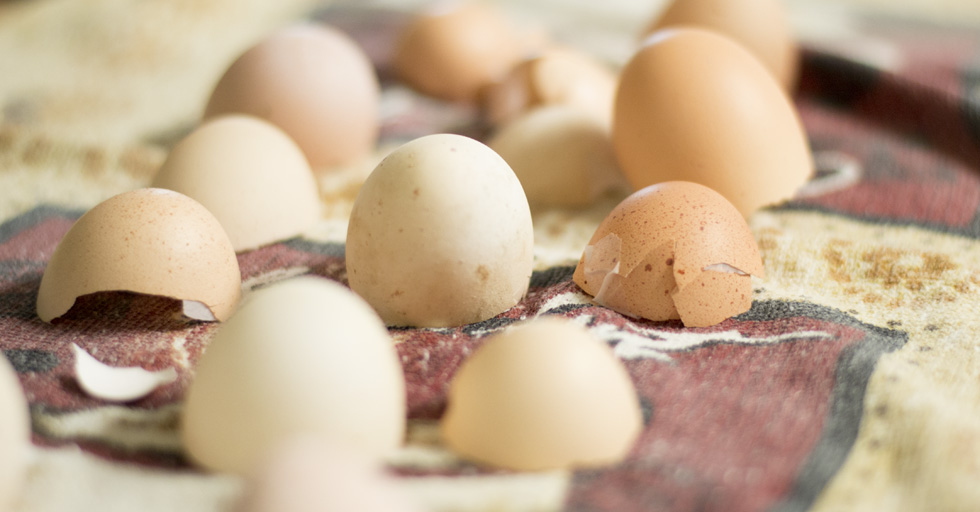
Before you start feeding your dog every raw meat in sight, there are some guidelines to follow and precautions that we’ve always taken. Whether this is too cautious, I’m not really sure (I’d rather be safe than sorry), but this is what we do and don’t do:
- The only raw meat we feed is chicken, beef, and wild game. As instructed by our vet, wild game MUST be frozen for 6 months before feeding it to our dog. This is because wild game here in a warm climate may contain parasites. USDA approved meat bought from the grocery store is safe for your pet and does not need to be frozen first.
- All other meat such as pork and fish, we feed cooked, with added calcium (eggshells).
- If the raw meat does not contain bone, we add calcium (eggshells).
- No meat in our house goes to waste. All raw fat and skin that may be cut off from chicken or beef that I would normally throw away – instead, it is fed to Roux.
- We also feed cooked bone, as long as it’s cooked down so much (such as in bone broth) that it can be pierced with a fork, and blended in a blender down to nothing (instructions below).
- IMPORTANT: When feeding raw bone, you must wait at least 8 hours between the next feeding of dry dog food. This is because they use a specific enzyme to breakdown bone and a different enzyme to breakdown dry dog food. Our vet told us that we could go completely raw once Roux is 7 months old. We still supplement with dry dog food, and she gets a raw meal a few times per week.
- I also mix up raw, fresh chicken eggs into her food sometimes.
- Carbs are kept to a minimum. Dogs do not need carbs in order to survive. Too many carbs will make them overweight and may contribute to future health problems. Again, check their dog food ingredients.
- I add nutritious raw veggies like spinach to her food sometimes. Too many Carrots seem to give her diarrhea, so we don’t give carrots anymore.
- For treats, we give her tiny pieces of bananas, blueberries, and dehydrated sweet potatoes.
Just like I preach about human food, the same goes for dog food. By reading the labels, you will find that most dog treats on the market contain dyes and chemicals, which are KNOWN toxins and have caused tumors in clinical trials.
Another thing I’ve learned about is diarrhea. If your dog has diarrhea, more than likely he or she is not getting enough bone in their diet.
If your dog does not already eat a raw diet and you would like to start, please read this article before switching. There is some important information you must know before starting a raw diet. Your current veterinarian may not know too much about feeding a raw diet in the same way that most human general practitioners do not teach much about the truth of proper nutrition to prevent disease in humans – they are heavily educated in treating disease with pharmaceuticals. You are more than welcome to bring it up at your next vet visit, but be forewarned that they may not be all too thrilled to assist you in this new adventure. And then again, they just might be.
If you would like to start caring for your dog naturally, I highly suggest finding a holistic vet in your area. If you are in our area, I highly recommend Dr. Segrera in Metairie, LA. It’s an hour drive to her office from our house, but it’s not like we go to the vet often. It’s worth the drive for us.
As for flea prevention, according to our vet, there is only one product on the market that is safe for human children to be around – Vectra. All other flea medication is in question for possibly causing leukemia in children. You can do what you want, but I’d rather be safe than sorry. We found it locally at Animal Kingdom Veterinary clinic in Houma, but I’m sure other vets sell it as well. For heartworm prevention, she recommended Interceptor every 3-6 months, not monthly.
To supplement calcium in Roux’s food, we use a method that our vet taught us. Otherwise, you can buy calcium powder. The method we use is much more cost efficient.
As we use eggshells, I rinse them off to get all the “slime” off.
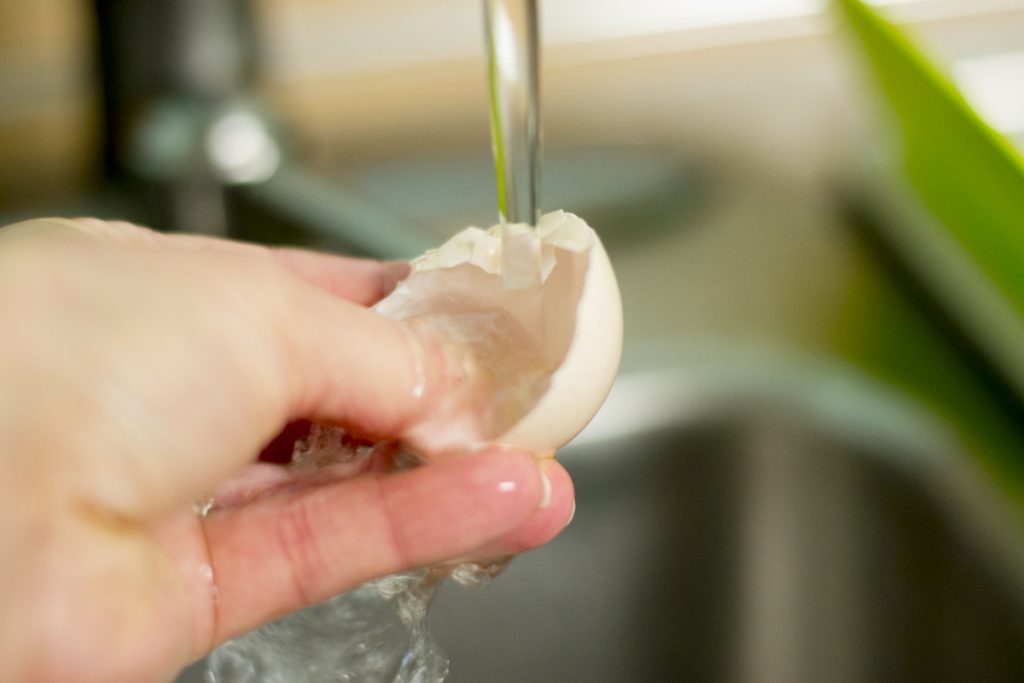
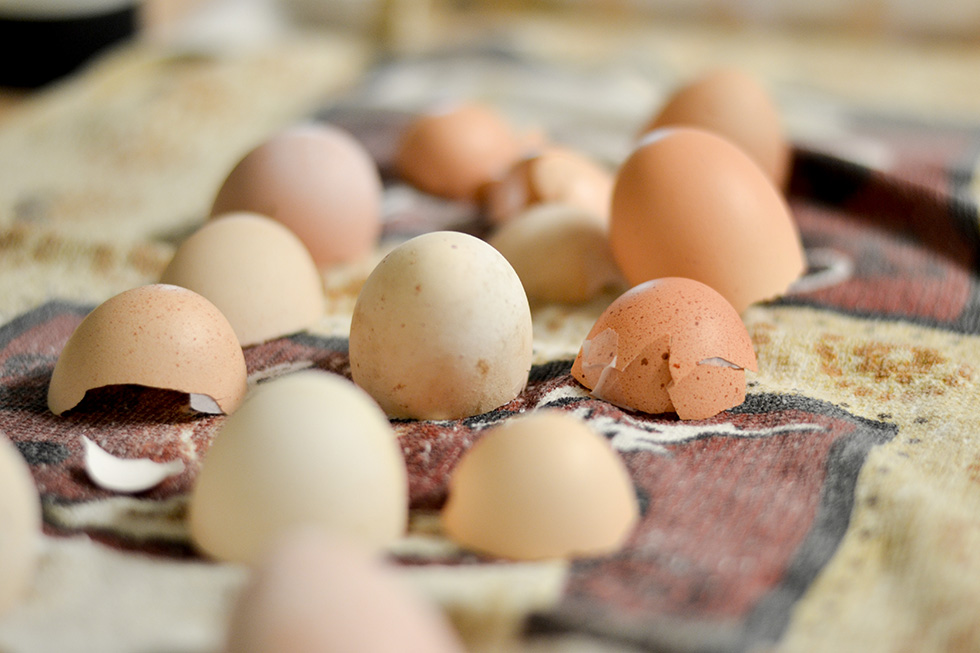
Once I have enough saved, I place them on a cookie sheet and bake at the oven’s lowest setting for about 20 minutes until completely dried out. Once completely dried out in the oven, put into a food processor and blend until finely broken.
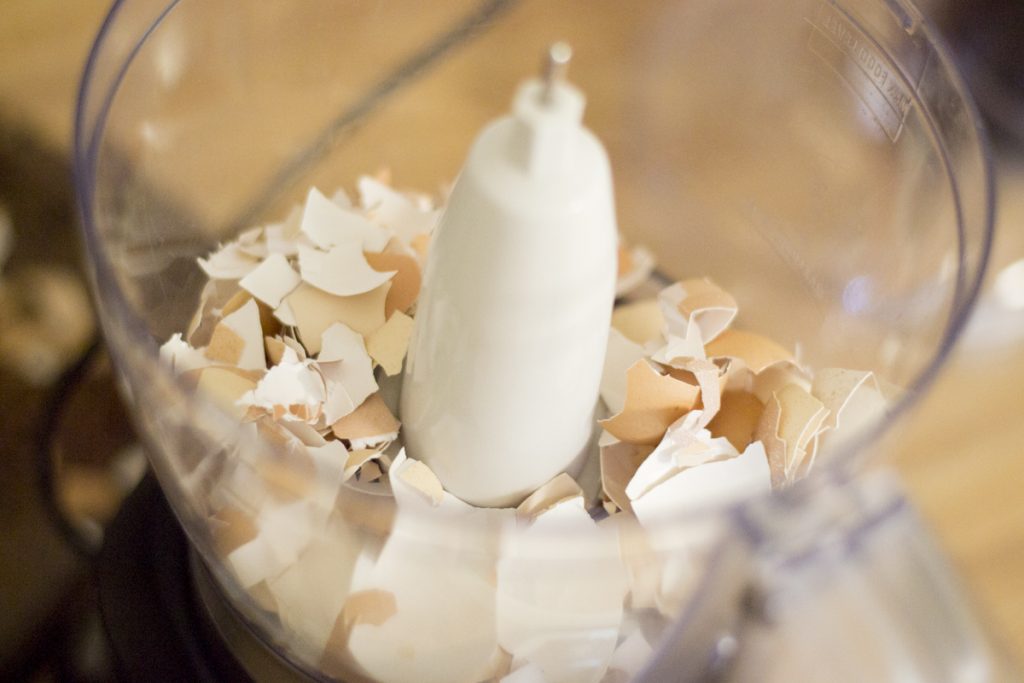
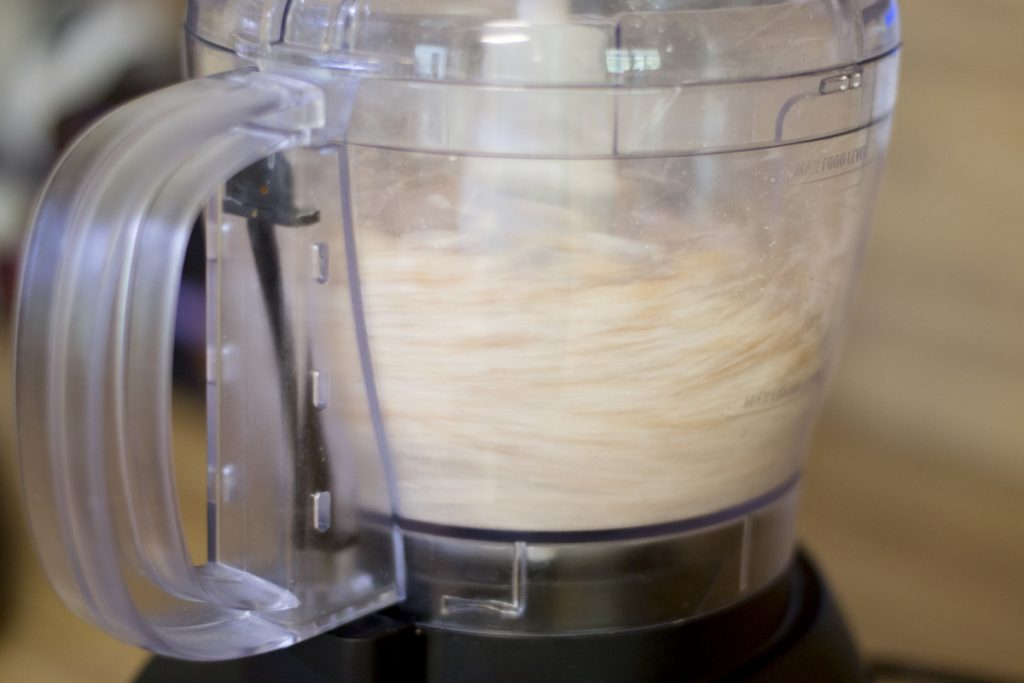
Store in a container. For every cup of raw meat, add 1 tsp of eggshells, as shown below.

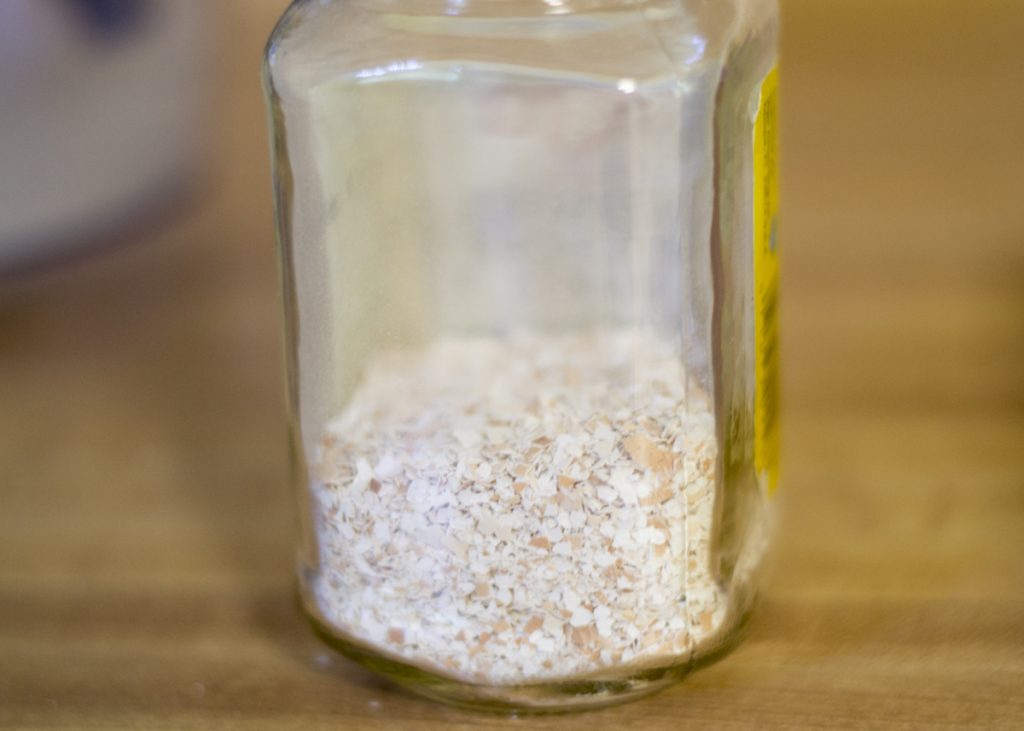
My favorite: THE LAZY METHOD: store the eggshells in a jar and crush them with my hands as I add them to the raw meat.
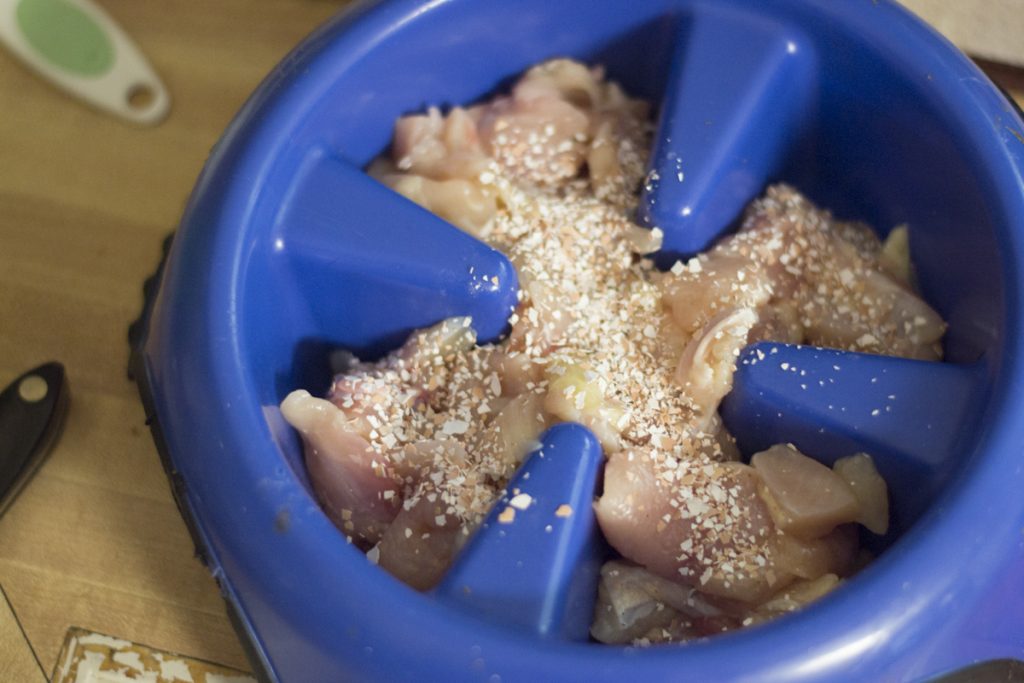
As you see above, this is all the fat pieces (also with meat pieces) that I cut off of the chicken breast we had for dinner. Check out this delicious chicken recipe here.
Like I said before, sometimes I mix it up with spinach as well. If I don’t have enough for one meal, I also add dry food. You CAN feed dry food with raw meat and eggshells, but you cannot feed dry food with raw meaty bone. Again, dry food must be given 8 hours before or after you feed raw meaty bone.
FEEDING COOKED BONE: Advice from our holistic vet
After making bone broth, I take all the cooked bones and skin/fat that have cooked down to nothing and put it into a blender. It’s so soft, the blender has no problem. Scoop into ice cube trays and freeze, then pop out and store in freezer bags. Two whole chicken carcasses used for bone broth filled up 2 1/2 ice cube trays. Add it as part of a daily meal, or for treats (defrosted).
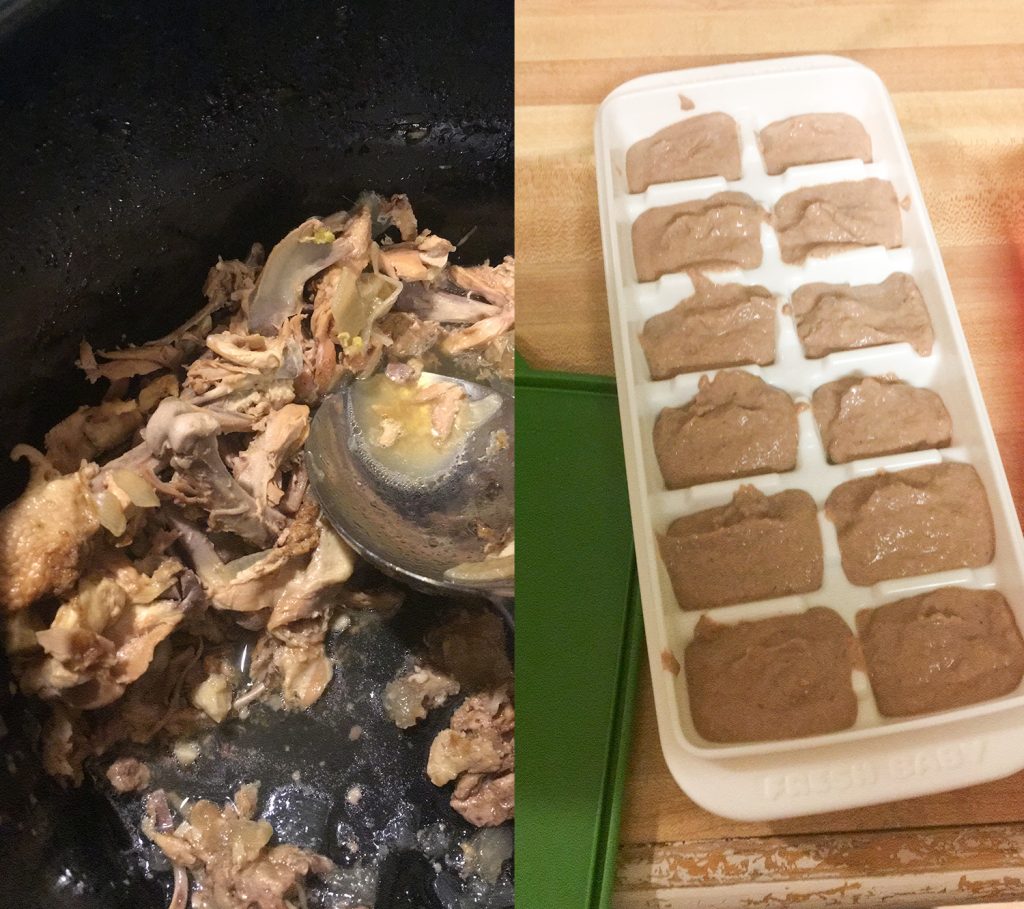
Some other natural things we use for Roux:
- One drop of peppermint oil in her water when she has an upset stomach. Also, pumpkin purée.
- Real elk antlers for chewing and dental hygene. Follow instructions on packaging for precautions.
- Virgin Coconut oil for teeth brushing.
- Spray a mixture of lavender essential oil and water on her bedding for a natural anti-microbial and freshener.
- Witch Hazel for ear cleaning. Soak a cotton ball with witch hazel and clean out ear canal until all debris is removed.
If you have any tips to share as well, feel free to comment below!
*this post has been updated and revised 7/28/21


